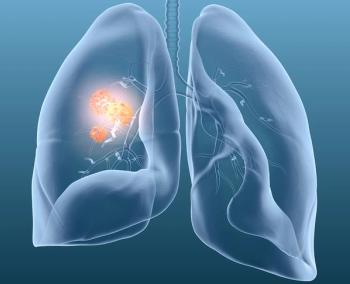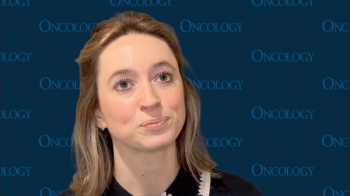
Brentuximab Vedotin Plus Chemotherapy Improves EFS Vs Chemotherapy Alone in Advanced Hodgkin Lymphoma
Findings from a randomized phase 3 trial indicated that brentuximab vedotin plus chemotherapy yielded a higher event-free survival rate and lowered the risk of death compared with chemotherapy alone among patients with advanced-stage Hodgkin Lymphoma.
The addition of brentuximab vedotin (Adcetris) to chemotherapy increased event-free survival (EFS) rates and demonstrated superior efficacy compared with chemotherapy alone as a treatment for patients with advanced-stage Hodgkin lymphoma, according to data from a randomized phase 3 trial (NCT02166463).
At a median follow-up of 42.1 months (range, 0.1-80.9), the 3-year EFS rates for the brentuximab vedotin and standard-care cohorts were 92.1% (95% CI, 88.4%-94.7%) and 82.5% (95% CI, 77.4%-86.5%), respectively (HR, 0.41; 95% CI, 0.25-0.67; P <.001). Additionally, the cumulative incidence of relapse was 7.5% (95% CI, 4.9%-10.9%) for patients in the brentuximab vedotin cohort and 17.1% (95% CI, 12.9%-21.8%) for patients in the standard-care arm. The 3-year overall survival (OS) rate was 99.3% (95% CI, 97.3%-99.8%) for patients in the brentuximab vedotin arm and 98.5% (95% CI, 96.0%-99.4%) for patients receiving standard-care chemotherapy. Overall, the investigators reported a 59.0% lower risk of an event or death with the addition of brentuximab vedotin to chemotherapy.
This open-label, multicenter, randomized phase 3 trial enrolled a total of 600 patients who were 2 to 21 years of age who had previously untreated stage IIB Hodgkin lymphoma with bulk tumor or stage IIIB, IVA, or IVB disease. A total of 298 patients were randomly assigned to receive a 1.8 mg/kg dose of brentuximab vedotin plus doxorubicin, vincristine, etoposide, prednisone, and cyclophosphamide, and 289 patients received the same chemotherapy alone. Treatment was administered every 21 days for 5 treatment cycles across both cohorts. Centrally reviewed positron-emission tomography was used to identify slow-responding lesions defined by a score of 4 or 5 on a 5-point scale following 2 treatment cycles. After 5 cycles of therapy, involved-site radiation therapy was administered to patients with slow-responding lesions and large mediastinal adenopathy present at diagnosis.
The primary end point of the trial was EFS, defined as the time until disease progression or relapse, a second malignant neoplasm developed, or patient death. Key secondary end points included interim response determined with a PET scan following 2 cycles of chemotherapy and the use of involved-site radiation therapy. Chemotherapy-induced peripheral neuropathy was a pre-specified secondary end point, and OS was an exploratory end point.
Among 587 eligible patients, most were male (53.0%) and non-Hispanic White (57.6%). Moreover, most patients had stage IV disease (60.1%); a large mediastinal mass (54.5%); and B symptoms such as weight loss, night sweats, and fever (71.2%). The median patients age was 15.6 years (range, 3.4-21.99), and 84.7% were 12 years or older at enrollment. According to the trial investigators, patient characteristics were balanced between both treatment cohorts.
A post-hoc analysis indicated that the 3-year EFS for patients with slow-responding lesions identified as such in the interim PET assessment was 90.7% for those in the brentuximab vedotin arm and 68.3% for patients who received standard chemotherapy (HR, 0.28; 95% CI, 0.10-0.76). Additionally, the 3-year EFS rates for patients with rapid-responding lesions in the brentuximab vedotin and standard-care cohorts, respectively, were 92.3% and 85.7% (HR, 0.48; 95% CI, 0.27-0.84). Involved-site radiation therapy was administered to 53.4% of patients in the brentuximab vedotin arm and 56.8% of those in the standard-care cohort.
The trial investigators also conducted an EFS subgroup analysis, to which they concluded, “Subgroup analyses of the primary end point indicated consistent effects of the brentuximab vedotin–based regimen across a variety of demographic and disease characteristics.”
Grade 3 or higher adverse effects (AEs) were observed among 73.5% and 68.2% of patients in the brentuximab vedotin and the standard-care cohorts, respectively. The most frequent AEs across each respective arm included febrile neutropenia (30.9% vs 32.5%), grade 2 or more peripheral neuropathy (18.8% vs 19.4%), mucositis or oral AEs (10.4% vs 7.3%), allergic reactions or anaphylaxis (4.0% vs 5.2%), elevated alanine aminotransferase levels (4.0% vs 3.1%), and sepsis (2.7% vs 4.2%). No deaths occurred during treatment.
Reference
Castellino SM, Pei Q, Parsons SK, et al. Brentuximab vedotin with chemotherapy in pediatric high-risk Hodgkin’s lymphoma. N Engl J Med. 2022;387:1649-60. doi:10.1056/NEJMoa2206660
Newsletter
Stay up to date on recent advances in the multidisciplinary approach to cancer.

















































































